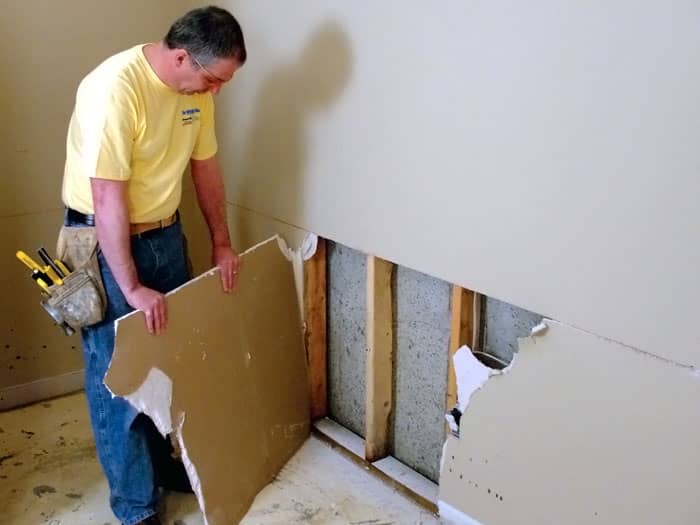Best Basement Waterproofing - The Facts
Best Basement Waterproofing - The Facts
Blog Article
Not known Factual Statements About Best Basement Waterproofing
Table of ContentsThe Buzz on Best Basement WaterproofingThe Buzz on Best Basement WaterproofingGetting My Best Basement Waterproofing To WorkNot known Facts About Best Basement Waterproofing10 Easy Facts About Best Basement Waterproofing Explained
AdvantaClean's trained specialists and professionals will certainly locate the water source. If wall or piece fractures are existing, we will certainly infuse polyurethane and epoxies right into the splits and secure the compromise, preventing further dampness from getting in.If there's condensation on the outside of the foil, you have high humidity in your basement. Fix it with a portable area dehumidifier or a whole-house humidifier system as opposed to waterproofing products. If the foil has condensation on the within surface (beside the wall), the soil around your house may be normally damp from a high water table or poor dirt drain.
You can waterproof simply your indoor wall surfaces, which may fix the trouble. Once they dry, they adhere completely to concrete and masonry wall surfaces.
The 8-Minute Rule for Best Basement Waterproofing
Swirl the brush at the final phase of application to offer the wall surface an attractive, finished look. Concrete waterproof layers can't be used to formerly painted surface areas; inspect the tag. A 5-gallon container prices about $60. Likewise known as densifiers, they appropriate only for wall surfaces that have not been painted or secured.
However you comb, roll, or spray it on much more heavily one gallon covers simply 75 square feet, not the 300 square feet typical with common paint. Water resistant paint is fine for do it yourself application. You can use it over painted surfaces, and paint over it once it's healed (one gallon expenses $37).
It can cost $10,000 to $15,000, depending on the work required. Exterior waterproofing involves excavating all around the residence to the complete depth of the foundation wall surfaces, after that setting up a water-proof covering or membrane layer covered by water drainage panels.
A basement without waterproofing is kind of like that. Your cellar doesn't want to go through a rainstorm without appropriate protection just as much as you do not desire to.
Not known Details About Best Basement Waterproofing
If you have actually done your research study, you would certainly understand there are 2 types of waterproofing: interior and outside. It can get perplexing what they both mean, which one's a much better investment, and what will actually maintain the water out. Don't stress, we placed with each other this blog site to conveniently specify both techniques for you look at more info and talk about the pros and disadvantages of each.
Outside waterproofing is a waterproofing technique that entails securing your home from the exterior. It's sort of like a moat around a castle. It includes excavating a trench around your entire house down to the foundation (about 8 to 10 feet down). The foundation wall surfaces are after that cleaned, secured, and covered with a water-proof membrane layer or sealant.

The 9-Second Trick For Best Basement Waterproofing
It's a more involved procedure that needs excavating up your yard, which is expensive and get redirected here time-consuming. Exterior waterproofing involves removing everything surrounding your house, consisting of decks, driveways, walkways, landscape design, air conditioner units, decks, and more. If any one of the job was done incorrectly and water is still entering your cellar, there isn't much you can do to remedy or repair it.
Interior cellar waterproofing entails waterproofing from the within. Any type of water that leakages right into your cellar is redirected before it touches your flooring. It's kind of like using a raincoat under your clothing. It entails two points: a water drainage track and a sump pump. It works by sealing the within your cellar wall surfaces and floors so water that attempts to enter is directed out with a sump pump.
It's an efficient method to waterproof your cellar. The downside of interior basement waterproofing mostly has to do with the installation process.
The Of Best Basement Waterproofing
In conclusion, exterior and indoor basement waterproofing are both efficient methods of shielding your home from water damages. Outside waterproofing creates a barrier that stops water from entering your home, while interior waterproofing reroutes water that does enter your home. And it's crucial to keep in mind that exterior waterproofing is a costly and turbulent setup process when compared to interior waterproofing.
Whichever technique you choose, ensure you select a dependable and credible specialist for the job. Both techniques call for knowledgeable workers to manage the task. If you their explanation have any type of inquiries about basement waterproofing, please reach out to us. And if you're in our service area and have water in your cellar, call us for a totally free, no-obligation home inspection.
You can complete our kind below, start a conversation in the bottom right-hand edge, or call us at 1-800-827-0702.
Report this page